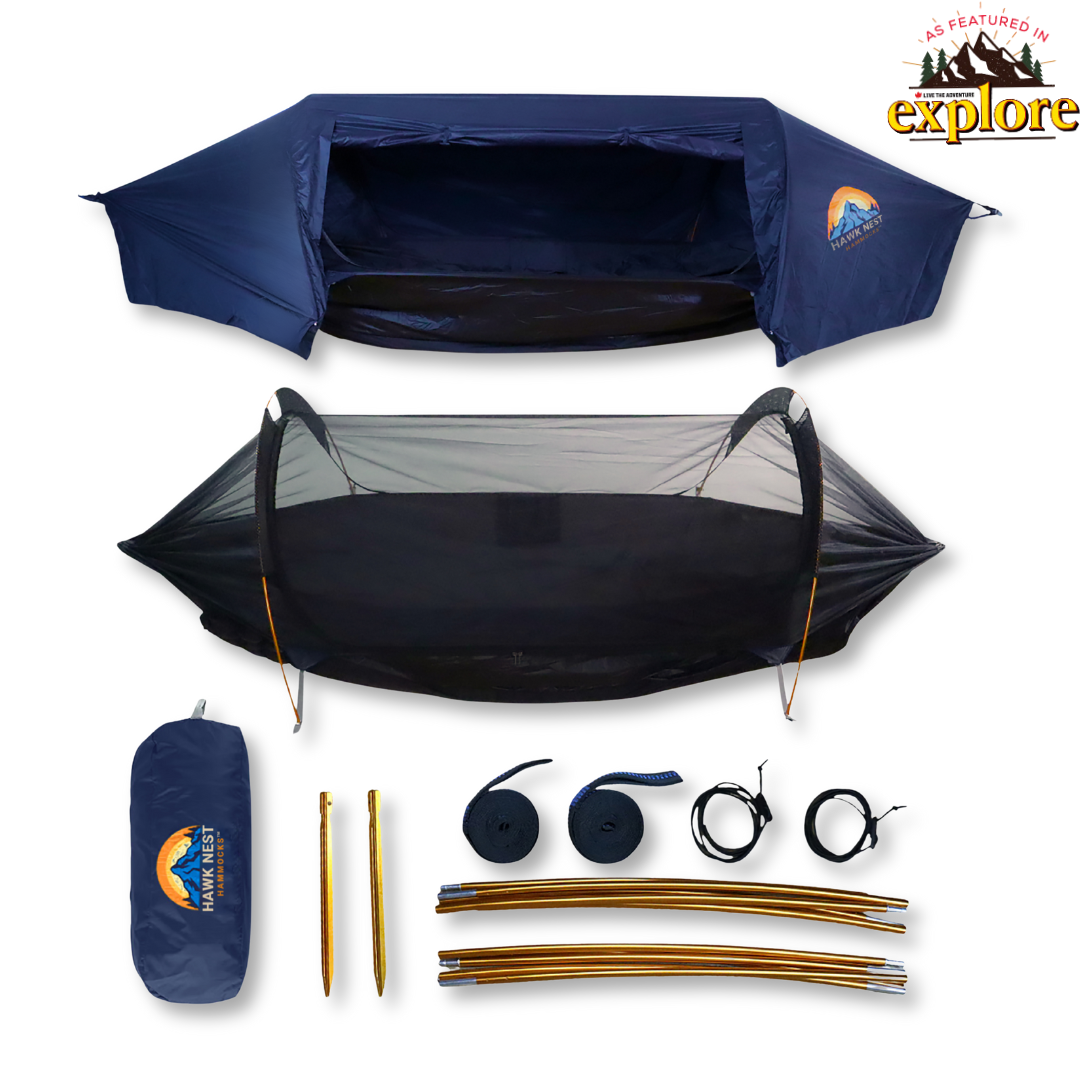Table of Contents
- Introduction to Hammock Tents for Kids
- Benefits of Hammock Tents for Kids
- Choosing the Right Hammock Tent for Kids
- How to Set Up a Hammock Tent for Kids
- Frequently Asked Questions
Introduction to Hammock Tents for Kids
Welcome to the delightful world of hammock tents for kids! These innovative tents offer a unique blend of fun and comfort, making them perfect for young adventurers. Whether you're planning a backyard sleepover or a family camping trip, a hammock tent can provide a cozy and exciting sleeping option for children.
Hammock tents for kids are designed to offer the same convenience and comfort as regular hammock tents but are tailored to the needs and preferences of children. They provide a safe and secure place for kids to sleep, play, and enjoy the great outdoors. This guide will introduce you to the benefits of hammock tents for kids, how to choose the right one, tips for setting it up, and more.
Imagine your child experiencing the joy of sleeping under the stars, swaying gently between trees, and feeling the cool breeze on their face. That's the magic of a hammock tent. From the forests of British Columbia to the serene lakes of Ontario, hammock tents offer a versatile and enjoyable camping experience for kids.
In the following sections, we'll explore the numerous benefits of using a hammock tent for kids, the key factors to consider when choosing one, and step-by-step instructions on setting it up. Get ready to embark on a family adventure that combines fun, comfort, and a touch of nature's wonder.
Benefits of Hammock Tents for Kids
Choosing a hammock tent for your child offers several advantages that enhance their outdoor experience. Let’s explore the unique benefits that make hammock tents an ideal choice for young campers.
Lightweight and Easy to Carry: Hammock tents for kids are designed to be lightweight and compact, making them easy for children to carry and set up with minimal assistance. This encourages independence and a sense of accomplishment in young campers.
Quick and Simple Setup: Hammock tents can be set up quickly and easily, which is perfect for kids who are eager to start their adventure. All you need are two trees or sturdy points, and your child will have a cozy place to rest in no time.
Comfortable and Elevated Sleeping: Hammock tents keep kids off the ground, away from dampness, insects, and uneven surfaces. This ensures a comfortable and undisturbed sleep, allowing them to wake up refreshed and ready for more fun.
Safe and Secure: Many hammock tents for kids come with integrated mosquito nets and weather-resistant covers, providing a safe and secure environment for your child to sleep in. This gives parents peace of mind while their children enjoy the outdoors.
Minimal Environmental Impact: Hammock tents leave little to no trace on the environment, as they do not require clearing the ground. This makes them an eco-friendly option for families who want to minimize their impact on nature.
Fun and Exciting: Sleeping in a hammock tent adds an element of adventure and excitement to any camping trip. Kids love the feeling of being suspended in the air, and it often becomes a highlight of their outdoor experience.
In conclusion, hammock tents for kids not only provide a practical and comfortable sleeping solution but also add a fun and adventurous element to their camping experience. They are lightweight, easy to set up, and environmentally friendly, making them a great choice for young outdoor enthusiasts.

Choosing the Right Hammock Tent for Kids
Selecting the right hammock tent for your child is crucial to ensure their comfort and safety. Here’s a guide to help you find the perfect hammock tent for your young adventurer.
Durability: Choose a hammock tent made from high-quality, durable materials like nylon or polyester. These materials are weather-resistant and can withstand the wear and tear of outdoor use, ensuring that the tent remains a reliable part of your camping gear.
Size and Weight Capacity: Consider the size and weight capacity of the hammock tent. It should be appropriately sized for your child and able to support their weight comfortably. Some hammock tents are designed for single children, while others can accommodate two kids.
Portability: Since children may need to carry their own gear, the hammock tent should be compact and lightweight. Many high-quality hammock tents fold into a small package, making them easy to transport and store.
Ease of Setup: Look for a hammock tent that is easy for children to set up and take down with minimal assistance. Adjustable straps and carabiners can simplify the process and allow kids to take part in the setup.
Integrated Features: Some hammock tents come with integrated features such as mosquito nets, rain flies, and pockets for small items. These features can greatly enhance your child’s camping experience by providing extra comfort and protection.
Safety Considerations: Ensure that the hammock tent has safety features like secure straps and sturdy carabiners. The tent should be stable and well-constructed to prevent any accidents during use.
Choosing the right hammock tent for your child involves considering their specific needs, the nature of your trips, and the environment you’ll be camping in. With the right hammock tent, you can ensure a comfortable, enjoyable, and safe camping experience for your young adventurer.
| Feature | Description | Benefits |
|---|---|---|
| Lightweight Material | Made from lightweight nylon or polyester. | Easy for kids to carry and set up. |
| Compact Design | Folds into a small package. | Fits easily in a backpack or small storage space. |
| Integrated Mosquito Net | Mesh netting to protect against insects. | Ensures a bug-free sleeping environment. |
| Waterproof Cover | Includes a rain fly or waterproof top. | Keeps kids dry during rain, enhancing comfort. |
| Easy Setup | Features adjustable straps and carabiners. | Can be quickly set up between two trees or posts. |
How to Set Up a Hammock Tent for Kids
Setting up a hammock tent for kids is a simple process, but it’s important to do it correctly to ensure comfort and safety. Here’s a step-by-step guide to help you set up a hammock tent for your child.
1. Choose the Right Location: Find a spot with two sturdy trees or posts about 10 to 15 feet apart. Make sure the area is free from sharp objects and potential hazards.
2. Inspect the Equipment: Before setting up, check the hammock tent, straps, and carabiners for any signs of wear and tear. Ensuring that everything is in good condition will prevent accidents.
3. Attach the Straps: Wrap the straps around each tree at about eye level or higher. Make sure the straps are flat against the tree and securely fastened. This will provide a stable base for the hammock tent.
4. Hook the Hammock: Attach the hammock tent to the straps using the carabiners. Adjust the height and tension to your child’s preference. A slight sag in the middle of the hammock is generally most comfortable.
5. Test the Hammock: Have your child sit in the hammock gently to test its stability and comfort. Make adjustments as needed to ensure it is well-balanced and comfortable.
6. Add Accessories: If the hammock tent includes a mosquito net or rain cover, attach these elements once the hammock is stable. This will protect your child from insects and weather conditions.
7. Final Checks: Double-check all connections and the hammock setup to ensure everything is secure. Look around the setup area one more time to confirm there are no potential hazards like loose branches above the hammock.
With these steps, you’ll be able to set up a hammock tent for your child quickly and ensure a comfortable, safe, and enjoyable camping experience. Proper setup is key to maximizing the benefits and enjoyment of a hammock tent.
Frequently Asked Questions
What is the best way to choose a location for setting up a hammock tent for kids?
Look for an area that is flat and free of sharp objects. The trees or posts you select for mounting the hammock should be sturdy and approximately 10 to 15 feet apart. Avoid areas under loose branches or near water bodies that might rise overnight.
How do I ensure the hammock tent is secure for my child?
Always check the durability of the straps and the stability of the carabiners before setup. Ensure that the straps are tightly wrapped around the trees and the carabiners are properly closed. Test the hammock by gently sitting in it before allowing your child to use it.
Can hammock tents for kids be used in rainy weather?
Yes, most hammock tents come with a rain fly to protect your child from the rain. Make sure the rain fly is properly positioned and secured to avoid water pooling and to ensure it provides complete coverage.
Is it safe for kids to use hammock tents alone?
It's generally safe if proper precautions are taken. Ensure that the setup is secure and that the hammock tent is inspected for any potential issues. Always supervise young children during the initial use and educate them on how to use it safely.
How do I pack a hammock tent for kids on a camping trip?
Ensure that the hammock tent is compactly folded and securely fastened to your child's backpack or storage bag. Use waterproof bags to protect it from the elements during the trip. Balance the load to maintain comfort and stability.
What accessories should I consider for a hammock tent for kids?
Consider accessories like a thicker rain fly, an underquilt for colder weather, and a gear sling to keep your child's belongings off the ground. These additions can enhance comfort and functionality during the camping trip.
For more detailed information on setting up and choosing hammock tents, visit: Hammock Setup Guide
Explore more tips and tricks for your outdoor adventures at: Mastering the Art of Hammock Tent Camping for Kids.
For the best hammock tents for kids, visit: Hawk Nest Hammocks - Hammock Tent for Kids.
For more information on our full range of products, visit our homepage: Hawk Nest Hammocks Home.


